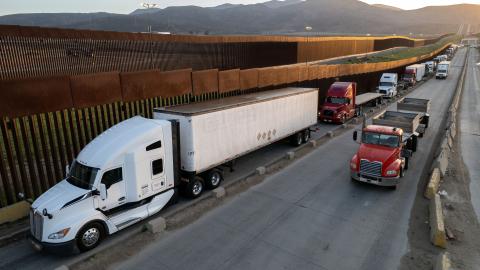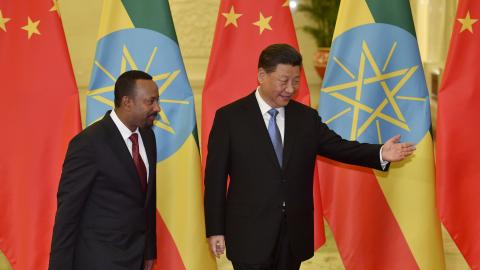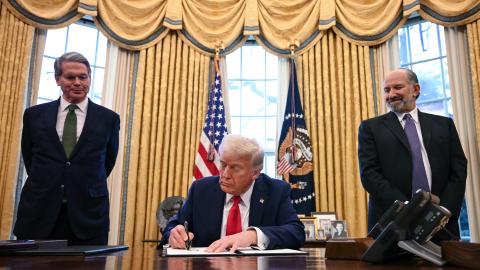US President Donald Trump’s 90-day pause on so-called reciprocal tariffs above 10 per cent for all economies except China has incensed Beijing. As China did back in 2018, when Trump first introduced his love of tariffs to the world, it is again seeking to seize the high moral ground.
Writing in The Sydney Morning Herald and The Age, China’s ambassador to Australia Xiao Qian positioned his country as the champion of globalisation and free trade, in juxtaposition to the United States as a hegemonic and short-sighted bully pursuing self-interested gains at the expense of the world.
Is Xiao correct that China is the responsible stakeholder of liberal economic globalism? It depends on whether one accepts his contention that China does not engage in erecting trade barriers, protectionism or unilateralism, as this is the basis for any high moral ground.
Beijing might insist on its own idiosyncratic definition of these terms. The reality is that it is not Trump but Chinese economic policies and practices over many decades that have created the greater distortion and constitute the greater challenge to the continuation of economic globalisation as we know it.
To make it clear, this piece is not offering the argument that Trump is a closet champion of the liberal global order. He isn’t. Trump believes that the globalisation of production has weakened American economic strength, resilience, and society.
In addition to fiscal revenue raising, tariffs are designed to incentivise firms to relocate operations to America if they want to sell to Americans. In this sense, I have consistently suggested that a baseline tariff of 10-20 per cent will remain a permanent feature of trade policy under his administration. Tariffs above that baseline figure can be negotiated down – but not when it comes to China.
Why is special pain being reserved for China? One might not agree with Trump’s love of tariffs or the benefits for American reindustrialisation that he believes they will lead to. But his gripe against China, that the latter is uniquely problematic in nature and scale, is based on evidence and fact.
“The poor separation of political and economic agency allows Beijing to blatantly manipulate markets and distort competition.”
Trump’s tariffs are easy to criticise because they are the most obvious form of protectionism and distortion of the liberal economic global system. In contrast, Chinese policies rely less on tariffs, although these exist. More grievously, China protects and assists its own firms using behind-the-border measures that give them unfair advantages over foreign competitors within the Chinese economy and globally.
For example, as pointed out by Brendan Pearson in The Australian Financial Review last month, a forensic and comprehensive report by the Organisation for Economic Co-operation and Development on industrial subsidies, covering almost 500 of the world’s largest manufacturing companies from over 50 countries, found that Chinese subsidies given to local firms surpassed the assistance other governments offer by a considerable margin.
In many cases, Chinese subsidies in sectors considered critical to national prosperity and strength, and in which global competition is most fierce, exceeded 15 per cent of revenue. The top 14 largest gains in market share in key manufacturing sectors since 2005 were by heavily subsidised Chinese firms.
In addition to subsidies, evidence of forced technology transfers made possible by insistence that foreign firms with more advanced know-how partner with Chinese firms when operating in China is incontrovertible.
Other countries’ IP
Chinese national intelligence and corporate legislation legalises large-scale and forced industrial and intellectual property transfer. Chinese economic policy enables and mandates it.
Even worse, the annual cost to the American economy from systematic industrial and intellectual property theft by China through cyber hacking could be as high as $US600 billion ($976 billion), according to the FBI. A leading cybersecurity firm, CrowdStrike, has found that over two-thirds of Chinese hackers are directly linked to the Chinese Communist Party.
More generally, a persuasive argument can be made that major aspects of the structure of the Chinese political economy are designed and evolving in ways to specifically circumvent the spirit and rules of the World Trade Organisation and other economic treaties and agreements. In particular, the poor separation of political and economic agency allows Beijing to blatantly manipulate markets and distort competition to achieve the CCP’s economic and geopolitical goals.
The problem is that WTO and other trade rules are not equipped to deal with a Chinese political economy that is neither a “command economy” nor a “market economy” as established under existing trade rules.
In particular, the complex and opaque networks of relationships and connections between the CCP, the state, regulatory entities, administrative entities, banks, businesses and individuals are unique to China and incomparable. In other words, WTO and other rules cannot cope nor sanction the activities and consequences arising out of the deep and opaque connections between the CCP and all major economic entities within China, whether state-owned or private.
The purpose in pointing out these Chinese policies and practices is that they offer Chinese entities unfair advantages on a nature and scale that undermines faith in and reliance on economic globalisation. Isn’t this the charge against Trump? And even then, Trump’s tariffs only apply to firms wanting to sell to Americans, while Chinese policies directly affect the market share of all firms in virtually every important sector in the global economy.
Major economies such as the EU and Japan might take issue with Trump’s tariffs. But they certainly do not accept China’s claim to be the champion of the liberal economic order and free trade.


















